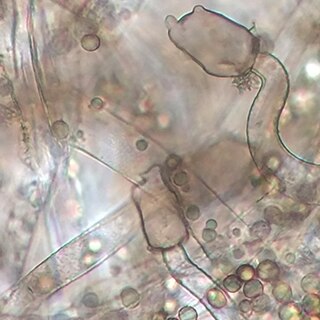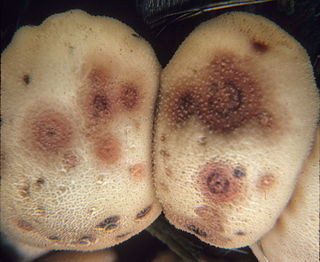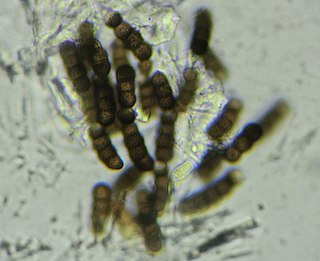
A mold or mould is one of the structures that certain fungi can form. The dust-like, colored appearance of molds is due to the formation of spores containing fungal secondary metabolites. The spores are the dispersal units of the fungi. Not all fungi form molds. Some fungi form mushrooms; others grow as single cells and are called microfungi.

Aspergillus flavus is a saprotrophic and pathogenic fungus with a cosmopolitan distribution. It is best known for its colonization of cereal grains, legumes, and tree nuts. Postharvest rot typically develops during harvest, storage, and/or transit. Its specific name flavus derives from the Latin meaning yellow, a reference to the frequently observed colour of the spores. A. flavus infections can occur while hosts are still in the field (preharvest), but often show no symptoms (dormancy) until postharvest storage or transport. In addition to causing preharvest and postharvest infections, many strains produce significant quantities of toxic compounds known as mycotoxins, which, when consumed, are toxic to mammals. A. flavus is also an opportunistic human and animal pathogen, causing aspergillosis in immunocompromised individuals.

Cladosporium is a genus of fungi including some of the most common indoor and outdoor molds. Some species are endophytes or plant pathogens, while others parasitize fungi.

Aspergillus terreus, also known as Aspergillus terrestris, is a fungus (mold) found worldwide in soil. Although thought to be strictly asexual until recently, A. terreus is now known to be capable of sexual reproduction. This saprotrophic fungus is prevalent in warmer climates such as tropical and subtropical regions. Aside from being located in soil, A. terreus has also been found in habitats such as decomposing vegetation and dust. A. terreus is commonly used in industry to produce important organic acids, such as itaconic acid and cis-aconitic acid, as well as enzymes, like xylanase. It was also the initial source for the drug mevinolin (lovastatin), a drug for lowering serum cholesterol.

Aspergillus versicolor is a slow-growing species of filamentous fungus commonly found in damp indoor environments and on food products. It has a characteristic musty odor associated with moldy homes and is a major producer of the hepatotoxic and carcinogenic mycotoxin sterigmatocystin. Like other Aspergillus species, A. versicolor is an eye, nose, and throat irritant.

Forensic mycology is the use of mycology in criminal investigations. Mycology is used in estimating times of death or events by using known growth rates of fungi, in providing trace evidence, and in locating corpses. It also includes tracking mold growth in buildings, the use of fungi in biological warfare, and the use of psychotropic and toxic fungus varieties as illicit drugs or causes of death.

Chaetomium globosum is a well-known mesophilic member of the mold family Chaetomiaceae. It is a saprophytic fungus that primarily resides on plants, soil, straw, and dung. Endophytic C. globosum assists in cellulose decomposition of plant cells. They are found in habitats ranging from forest plants to mountain soils across various biomes. C. globosum colonies can also be found indoors and on wooden products.

Mucor plumbeus is a fungus in the family Mucoraceae that is very common, abundant and distributed worldwide. Mucor plumbeus is not known to be a plant or animal pathogen; however it is able to elicit an immune response in humans by activating the complement system. This species is commonly found in various types of soils over a range of pH, although alkaline soils seem more conducive to its growth. It is also known from the roots of wheat, oat and barley. In addition, M. plumbeus is a common fungal contaminant of indoor built environments. This species shares many similarities with M. racemosus, another fungus that belongs to the family Mucoraceae which is known to cause mucormycosis. Mucor plumbeus is a common spoilage agent of cheese, apples, apple cider and yogurt.

Epicoccum nigrum is a species of fungus in the phylum Ascomycota. A plant pathogen and endophyte, it is a widespread fungus which produces coloured pigments that can be used as antifungal agents against other pathogenic fungi. The fluorescent stain epicocconone is extracted from it.

Cladosporium cladosporioides is a darkly pigmented mold that occurs world-wide on a wide range of materials both outdoors and indoors. It is one of the most common fungi in outdoor air where its spores are important in seasonal allergic disease. While this species rarely causes invasive disease in animals, it is an important agent of plant disease, attacking both the leaves and fruits of many plants. This species produces asexual spores in delicate, branched chains that break apart readily and drift in the air. It is able to grow under low water conditions and at very low temperatures.

Zasmidium cellare, also known as cellar mold, is a species of fungus that exists in dark, ethanol-rich environments and is brown to black in colour. This species primarily exists in wine and brandy cellars in central and southern Europe, but can be found in surrounding regions and is thought to be helpful in the wine making process by some and a hygienic issue by others. Not much is known about Z. cellare's sexual biology and is thought to be beneficial to the cleanliness of cellar air due to its ability to consume musty odours.

Cladosporium sphaerospermum is a radiotrophic fungus belonging to the genus Cladosporium and was described in 1886 by Albert Julius Otto Penzig from the decaying leaves and branches of Citrus. It is a dematiaceous (darkly-pigmented) fungus characterized by slow growth and largely asexual reproduction. Cladosporium sphaerospermum consists of a complex of poorly morphologically differentiated, "cryptic" species that share many physiological and ecological attributes. In older literature, all of these sibling species were classified as C. sphaerospermum despite their unique nature. Accordingly, there is confusion in older literature reports on the physiological and habitat regularities of C. sphaerospermum in the strict sense. This fungus is most phylogenetically similar to C. fusiforme. According to modern phylogenetic analyses, the previously synonymized species, Cladosporium langeroni, is a distinct species.
Cladosporium ear rot is a disease that affects maize. The disease is caused by the saprophytic fungus Cladosporium herbarum and is characterized by black or dark green fungal growths that cause black streaks on kernels.

Penicillium spinulosum is a non-branched, fast-growing fungus with a swelling at the terminal of the stipe (vesiculate) in the genus Penicillium. P. spinulosum is able to grow and reproduce in environment with low temperature and low water availability, and is known to be acidotolerant. P. spinulosum is ubiquitously distributed, and can often be isolated from soil. Each individual strain of P. spinulosum differs from others in their colony morphology, including colony texture, amount of sporulation and roughness of conidia and conidiophores.
Cladosporium oxysporum is an airborne fungus that is commonly found outdoors and is distributed throughout the tropical and subtropical region, it is mostly located In Asia and Africa. It spreads through airborne spores and is often extremely abundant in outdoor air during the spring and summer seasons. It mainly feeds on decomposing organic matter in warmer climates, but can also be parasitic and feed on living plants. The airborne spores can occasionally cause cutaneous infections in humans, and the high prevalence of C. oxysporum in outdoor air during warm seasons contributes to its importance as an etiological agent of allergic disease and possibly human cutaneous phaeohyphomycosis in tropical regions.
Aspergillus wentii is an asexual, filamentous, endosymbiotic fungus belonging to the mold genus, Aspergillus. It is a common soil fungus with a cosmopolitan distribution, although it is primarily found in subtropical regions. Found on a variety of organic materials, A. wentii is known to colonize corn, cereals, moist grains, peanuts and other ground nut crops. It is also used in the manufacture of biodiesel from lipids and is known for its ability to produce enzymes used in the food industry.
Curvularia pallescens is a soil fungus, that commonly grows on crops found in tropical regions. The conidia of the fungus are distinguishable from those of related species due to their lack of curvature. C. pallescens has been reported to cause infection in plants, and in immunocompetent individuals. This species is the anamorph of Cochliobolus pallescens.

Mariannaea elegans an anamorphic fungus. It is mainly found on rotting wood and soil. M. elegans is not pathogenic to humans, animals, or plants.

Torula herbarum is a darkly-pigmented filamentous fungus in the phylum Ascomycota. It is often included in the unrelated but morphologically similar group of fungi known as sooty molds. It was first described by Persoon in the genus Monilinia based on similarity to the agent of brown rot of stone fruit but later transferred to the genus Torula by Link. Conidia of T. herbarum are dark brown or olivaceous colour and have a distinctive shape and number of cells. T. herbarum produces secondary metabolites with cytotoxic activity towards bacteria and human cancer cells.
Oidiodendron cereale is a species of ascomycetes fungi in the order Helotiales. This fungus is found globally in temperate climates where average summer temperatures are below 25 °C, but there have been scattered reports from tropical and subtropical environments. It is predominantly found in soil, but little is known regarding their ecological roles in nature. However, an enzymatic study from Agriculture Canada showed that O. cereale can break down a variety of plant, fungal, and animal based substrates found in soil, which may have beneficial effects for plants. On rare occasions, this fungus is found on human skin and hair. There has been one reported case of O. cereale infection in 1969, causing Neurodermitis Nuchae.














